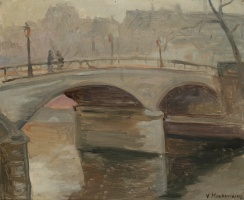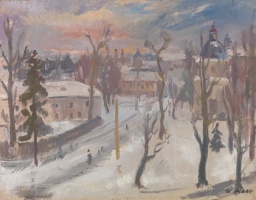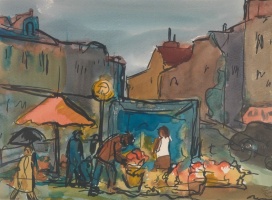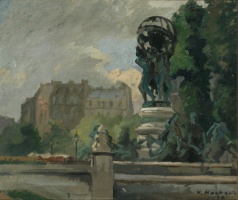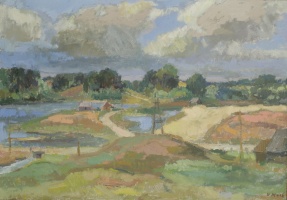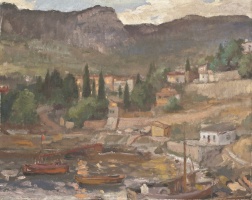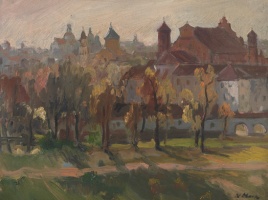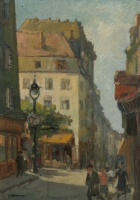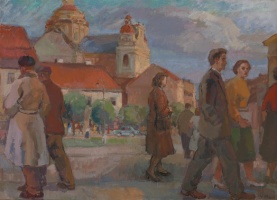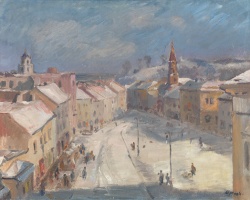
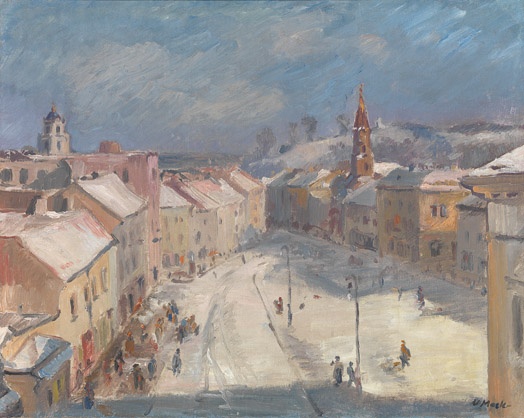
Vilnius. Didžioji Street
| Author: |
Vytautas Mackevičius (1911–1991)  |
| Created: | 1942 |
| Material: | canvas, cardboard |
| Technique: | oil |
| Dimensions: | 55 × 69 cm |
| Signature: | bottom right: V Mack-, inscription on the reverse side: 34. Rankraštinio katalogo numeracija |
Vytautas Mackevičius (1911–1991) studied painting at Kaunas School of Art under Petras Kalpokas and Vladas Didžiokas, and continued his studies in Paris in 1938 and 1939. He participated in left-wing activities when he was a student, and was an inspector on the Board of Artistic Affairs in Soviet Lithuania in 1940 and 1941. During the German occupation, he lived in Vilnius at risk of being denounced for his Soviet past. He produced some townscapes during the war which he painted from the windows of his acquaintances, in order to avoid being noticed. He painted Vilnius. Didžioji Street from the window of the studio of his colleague Adolfas Valeška in Vokiečių Street. Valeška headed the Vilnius Art Museum between 1940 and 1944, which was in the Town Hall, and lived and worked in his studio beside it. The quivering air, and the contrast between the blue shadows and the sunlit side of the square, are witnesses to the lessons in Impressionism taken by Mackevičius. The picture expresses the spirit of wartime Vilnius, the dismal feeling, and the empty snow-covered square in front of the Town Hall. The cold blue tone of the picture adds to the unsettled mood.
Text author Laima Laučkaitė
Vilnius is often seen through a window in wartime works. When the Nazis banned painting in the streets, artists found a way out by capturing views of the city from safe private spaces, such as their or their friends’ homes, offices or studios. One of the hubs of artistic life in Vilnius at that time was the Vilnius Art Museum in the Town Hall, directed by Adolfas Valeška (1905–1994). Before moving to the regained capital in 1939, Valeška had been a collector of folk art and head of the Museum of Church Art in Kaunas. In his painting Vilnius through the museum window, we can see not only a view of the city with Town Hall Square, but also Lithuanian cultural symbols that the artist considered relevant: a sculpture of the Mother of God carved by a folk craftsman, and some fabric with folk patterns.
Vytautas Mackevičius (1911–1991) also painted the city through a window, but for rather different reasons. In 1940 and 1941, he had worked in Soviet Lithuania as an inspector for the Board of Art Affairs, so during the Nazi occupation he tried to keep a low profile, and painted Town Hall Square from Valeška’s studio, which was next to the museum.
Algirdas Petrulis (1915–2010) was employed as a curator at the museum run by Valeška. The view Vokiečių Street in Vilnius that he painted through the museum window, capturing part of the Old Town that was later destroyed during the Soviet occupation, is now part of history.
Text authors Dovilė Barcytė and Ieva Burbaitė
Source: Law firm Valiunas Ellex art album VILNIUS. TOPOPHILIA I (2014). Compiler and author Laima Laučkaitė, KAUNAS–VILNIUS / 1918–1945 (2021). Compilers and text authors Dovilė Barcytė and Ieva BurbaitėExpositions: “Vilnius. Topophilia. Views of Vilnius from the collection of the law firm Ellex Valiunas”, 5 October – 26 November 2017, National Gallery of Art, Vilnius. Curator Laima Laučkaitė; "A Glance at the History of Lithuanian Art from Užupis", 30 August 2018 – 1 June 2019, Lithuanian Art Centre TARTLE (Užupio St. 40, Vilnius). Curator Giedrė Jankevičiūtė. "Didžioji Street", 26 September 2019 – 12 January 2020, Vilnius Picture Gallery (Didžioji St. 4, Vilnius). Curators: Margarita Matulytė (project leader), Justina Augustytė, Donatas Snarskis.







